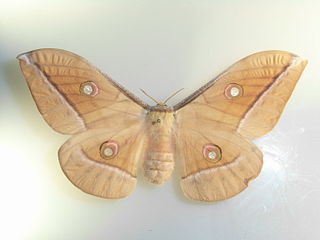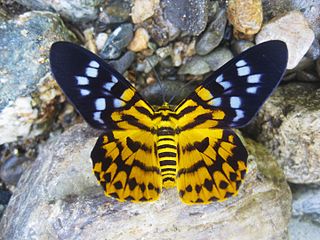Aclytia is a genus of tiger moths in the family Erebidae. The genus was erected by Jacob Hübner in 1819.

Cyanopepla is a genus of moths in the subfamily Arctiinae. The genus was erected by James Brackenridge Clemens in 1861.

Eucereon is a genus of tiger moths in the family Erebidae. The genus was erected by Jacob Hübner in 1819.

The subfamily Aphaeninae is a group of hemipteran insects, especially abundant and diverse in the tropics. They belong to the Fulgoridae (fulgorids), though they are not among the better-known members of that family that are called "lantern bugs" or "lanternflies". In 2009, the first molecular analysis of the Fulgoridae challenged the existing structure of eight currently recognized subfamilies and eleven tribes.

Isanthrene is a genus of moths in the subfamily Arctiinae. The genus was erected by Jacob Hübner in 1819.

Comostola is a genus of moths in the family Geometridae erected by Edward Meyrick in 1888. They are found primarily in Asia and Australia.

Plutodes is a genus of moths in the family Geometridae erected by Achille Guenée in 1857.
Protuliocnemis is a genus of moths in the family Geometridae erected by Jeremy Daniel Holloway in 1996.

Antheraea is a moth genus belonging to the family Saturniidae. The genus was erected by Jacob Hübner in 1819. Several species of this genus have caterpillars which produce wild silk of commercial importance. Commonly called "tussar silk", the moths are named tussar moths after the fabric.

Rothschildia is a genus of moths in the family Saturniidae first described by Augustus Radcliffe Grote in 1896.

Oleria is a genus of clearwing (ithomiine) butterflies, named by Jacob Hübner in 1816. They are in the brush-footed butterfly family, Nymphalidae.

Comostola laesaria is a moth of the family Geometridae first described by Francis Walker in 1861. It is found in Sri Lanka, India, Indochina, southern China, Taiwan, Sundaland, northern Australia and the Bismarck Archipelago.

Spodoptera picta, the lily caterpillar, is a moth of the family Noctuidae. It was described by Félix Édouard Guérin-Méneville in 1838. It is found in India, Sri Lanka, Australia and Japan.

Mecopodinae, the long-legged katydids, are a subfamily of bush crickets found in western South America, sub-Saharan Africa, and Asia. In Asia, the distribution includes India, Indochina, Japan, the Philippines, and Malesia to Papua New Guinea and Australasia, including many Pacific islands.

Carallia brachiata is a large tree in the family Rhizophoraceae, that grows to a height of 25 metres and found from Australia, Malesia, Indochina through to the Western Ghats. It is the host plant of the moth Dysphania percota in India and Dysphania numana in Australia.

Dysphania palmyra, the blue tiger moth or blue day moth, is a moth of the family Geometridae. The species was first described by Caspar Stoll in 1790. It is found in India and Sri Lanka.

Dysphania subrepleta is a species of false tiger moth in the subfamily Geometrinae. Records are from Indo-China and western Malesia including Borneo, with no subspecies listed in the Catalogue of Life, where it is a "provisionally accepted name".
















